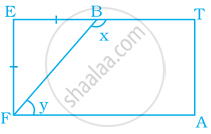Advertisements
Advertisements
Question
In Fig. 17.29, suppose it is known that DE = DF. Then, is ΔABC isosceles? Why or why not?
Solution
\[\text{ In } ∆ FDE: \]
\[DE = DF \]
\[ \therefore \angle FED = \angle DFE . . . . . . . . . . . . . (i) (\text{ angles opposite to equal sides })\]
\[\text{ In the } {II}^{gm} BDEF: \]
\[\angle FBD = \angle FED . . . . . . . (ii) (\text{ opposite angles of a parallelogram are equal })\]
\[\text{ In the } {II}^{gm} DCEF: \]
\[\angle DCE = \angle DFE . . . . . . (iii) (\text{ opposite angles of a parallelogram are equal })\]
\[\text{ From equations } (i), (ii) \text{ and } (iii): \]
\[\angle FBD = \angle DCE\]
\[\text{ In } \bigtriangleup ABC: \]
\[If \angle FBD = \angle DCE, \text{ then } AB = AC (\text{ sides opposite to equal angles }) . \]
\[\text{ Hence }, \bigtriangleup ABC \text{ is isosceles }.\]
APPEARS IN
RELATED QUESTIONS
Name the quadrilaterals whose diagonals are equal
Which of the following statement is true for a rectangle?
Its diagonals bisect each other.
Which of the following statement true for a square?
Its diagonals bisect each other at right angle.
Draw a square whose each side measures 4.8 cm.
State with reason whether the following statement is ‘true’ or ‘false’.
Every parallelogram is a rectangle.
Show that the bisectors of angles of a parallelogram form a rectangle
Rectangle is a regular quadrilateral.
If diagonals of a quadrilateral are equal, it must be a rectangle.
PQRS is a rectangle. The perpendicular ST from S on PR divides ∠S in the ratio 2:3. Find ∠TPQ.
A playground is in the form of a rectangle ATEF. Two players are standing at the points F and B where EF = EB. Find the values of x and y.

